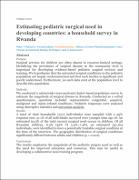| dc.contributor.author | Petroze, Robin T | |
| dc.contributor.author | Calland, J Forrest | |
| dc.contributor.author | Niyonkuru, Francine | |
| dc.contributor.author | Groen, Reinou S | |
| dc.contributor.author | Kyamanywa, Patrick | |
| dc.contributor.author | Li, Yue | |
| dc.contributor.author | Guterbock, Thomas M | |
| dc.contributor.author | Rodgers, Bradley M | |
| dc.contributor.author | Rasmussen, Sara K | |
| dc.date.accessioned | 2022-04-07T12:37:09Z | |
| dc.date.available | 2022-04-07T12:37:09Z | |
| dc.date.issued | 2014 | |
| dc.identifier.citation | Petroze, R.T., Calland, J.F., Niyonkuru, F., Groen, R.S., Kyamanywa, P., Li, Y., Guterbock, T.M., Rodgers, B.M. and Rasmussen, S.K. (2014). Estimating pediatric surgical need in developing countries: a household survey in Rwanda. Journal of pediatric surgery, 49(7), pp.1092-1098. | en_US |
| dc.identifier.issn | 0022-3468 | |
| dc.identifier.issn | 1531-5037 | |
| dc.identifier.uri | http://hdl.handle.net/20.500.12280/2925 | |
| dc.description.abstract | Purpose
Surgical services for children are often absent in resource-limited settings. Identifying the prevalence of surgical disease at the community level is important for developing evidence-based pediatric surgical services and training. We hypothesize that the untreated surgical conditions in the pediatric population are largely uncharacterized and that such burden is significant and poorly understood. Furthermore, no such data exist at the population level to describe this population.
Methods
We conducted a nationwide cross-sectional cluster-based population survey to estimate the magnitude of surgical disease in Rwanda. Conducted as a verbal questionnaire, questions included representative congenital, acquired, malignant and injury-related conditions. Pediatric responses were analyzed using descriptive statistics and univariate analysis.
Results
A total of 1626 households (3175 individuals) were sampled with a 99% response rate; 51.1% of all individuals surveyed were younger than age 18. An estimated 50.5% of the total current surgical need occurs in children. Of all Rwandan children, 6.3% (95% CI 5.4%–7.4%), an estimated 341,164 individuals, were identified to have a potentially treatable surgical condition at the time of the interview. The geographic distribution of surgical conditions significantly differed between adults and children (p < 0.001).
Conclusions
The results emphasize the magnitude of the pediatric surgery need as well as the need for improved education and resources. This may be useful in developing a collaborative local training program. | en_US |
| dc.language.iso | en | en_US |
| dc.publisher | W B Saunders Co-Elsevier Inc , 1600 John F Kennedy Boulevard, Ste 1800, Philadelphia, Usa, Pa, 19103-2899 | en_US |
| dc.relation.ispartofseries | Journal of pediatric surgery;49(7) | |
| dc.subject | Pediatric surgical | en_US |
| dc.subject | Surgical need | en_US |
| dc.subject | Developing countries | en_US |
| dc.subject | Rwanda | en_US |
| dc.title | Estimating Pediatric Surgical Need in Developing Countries: A Household Survey in Rwanda | en_US |
| dc.type | Article | en_US |


